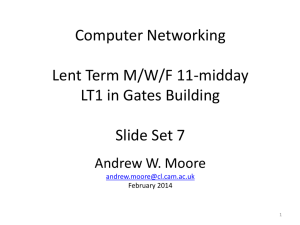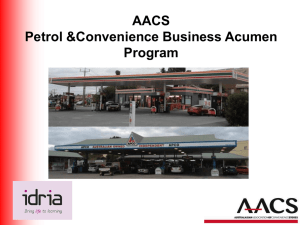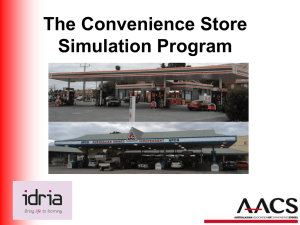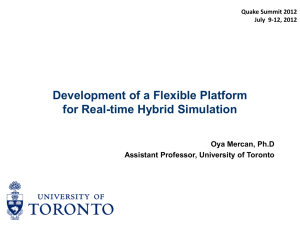Par Lab OS and Architecture Research
advertisement
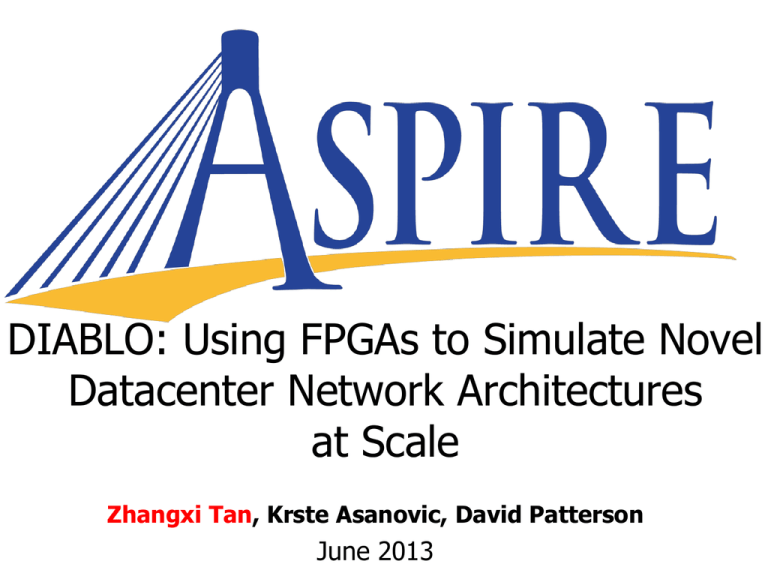
DIABLO: Using FPGAs to Simulate Novel Datacenter Network Architectures at Scale Zhangxi Tan, Krste Asanovic, David Patterson June 2013 Agenda Motivation Computer System Simulation Methodology DIABLO: Datacenter-in-Box at Low Cost Case Studies Experience and Lessons learned 2 Datacenter Network Architecture Overview Conventional datacenter network (Cisco’s perspective) Figure from “VL2: A Scalable and Flexible Data Center Network” 3 Observations Network infrastructure is the “SUV of datacenter” 18% monthly cost (3rd largest cost) Large switches/routers are expensive and unreliable Important for many optimizations: Improving server utilization Supporting data intensive map-reduce jobs Source: James Hamilton, Data Center Networks Are in my Way, Stanford Oct 2009 4 Advances in Datacenter Networking Many new network architectures proposed recently focusing on new switch designs Research : VL2/monsoon (MSR), Portland (UCSD), Dcell/Bcube (MSRA), Policy-aware switching layer (UCB), Nox (UCB), Thacker’s container network (MSR-SVC) Product : Google g-switch, Facebook 100 Gbps Ethernet and etc. Different observations lead to many distinct design features Switch designs Packet buffer micro-architectures Programmable flow tables Application and protocols ECN support 5 Evaluation Limitations The methodology to evaluate new datacenter network architectures has been largely ignored Scale is way smaller than real datacenter network <100 nodes, most of testbeds < 20 nodes Synthetic programs and benchmarks Datacenter Programs: Web search, email, map/reduce Off-the-shelf switches architectural details are proprietary Limited architectural design space configurations: E.g. change link delays, buffer size and etc. How to enable network architecture innovation at scale without first building a large datacenter? 6 A wish list of networking evaluations Evaluating networking designs is hard Datacenter scale at O(10,000) -> need scale Switch architectures are massively paralleled -> need performance Large switches has 48~96 ports, 1K~4K flow tables/port. 100~200 concurrent events per clock cycles Nanosecond time scale -> need accuracy Transmit a 64B packet on 10 Gbps Ethernet only takes ~50ns, comparable to DRAM access! Many fine-grained synchronization in simulation Run production software -> need extensive application logic 7 My proposal Use Field Programmable Gate Array (FPGAs) Logic Block latch set by configuration bit-stream 1 INPUTS 4-LUT FF OUTPUT 0 4-input "look up table" DIABLO: Datacenter-in-Box at Low Cost Abstracted execution-driven performance models Cost ~$12 per node. 8 Agenda Motivation Computer System Simulation Methodology DIABLO: Datacenter-in-Box at Low Cost Case Studies Experience and Lessons learned Future Directions 9 Computer System Simulations Terminology Host vs. Target Target: Systems being simulated, e.g. servers and switches Host: The platform on which the simulator runs, e.g. FPGAs Taxonomy Software Architecture Model Execution (SAME) vs FPGA Architecture Execution (FAME) A case for FAME: FPGA architecture model execution, ISCA’10 10 Software Architecture Model Execution (SAME) Median Instructions Median Simulated/ #Cores Benchmark Median Instructions Simulated/ Core ISCA 1998 267M 1 267M ISCA 2008 825M 16 100M Issues: Dramatically shorter simulation time! (~10ms) Datacenter: O(100) seconds or more Unrealistic models, e.g. infinite fast CPUs 11 FPGA Architecture Execution (FAME) FAME: Simulators built on FPGAs Not FPGA computers Not FPGA accelerators Three FAME dimensions: Direct vs Decoupled Direct: Target cycles = host cycles Decoupled: Decouple host cycles from target cycles use models for timing accuracy Full RTL vs Abstracted Full RTL: resource inefficient on FPGAs Abstracted: modeled RTL with FPGA friendly structures Single vs Multithreaded host 12 Host multithreading Example: simulating four independent CPUs CPU 0 Target Model CPU 1 CPU 2 CPU 3 Functional CPU model on FPGA PC PC1 PC PC1 1 1 Thread Select I$ GPR1 GPR1 GPR1 GPR1 DE IR X A L U D$ Y +1 2 2 2 Target Cycle: 0 1 2 Host Cycle: 0 1 2 3 4 5 6 7 8 9 10 Instruction in Functional Model Pipeline: i0 i0 i0 i0 i1 i1 i1 i1 i2 i2 i2 13 RAMP Gold: A Multithreaded FAME Simulator Rapid accurate simulation of manycore architectural ideas using FPGAs Initial version models 64 cores of SPARC v8 with shared memory system on $750 board Hardware FPU, MMU, boots OS. Cost Simics (SAME) RAMP Gold (FAME) Performance (MIPS) Simulations per day $2,000 0.1 - 1 1 $2,000 + $750 50 - 100 250 14 Agenda Motivation Computer System Simulation Methodology DIABLO: Datacenter-in-Box at Low Cost Case Studies Experience and Lessons learned 15 DIABLO Overview Build a “wind tunnel” for datacenter network using FPGAs Simulate O(10,000) nodes: each is capable of running real software Simulate O(1,000) datacenter switches (all levels) with detail and accurate timing Simulate O(100) seconds in target Runtime configurable architectural parameters (link speed/latency, host speed) Built with the FAME technology Executing real instructions, moving real bytes in the network! 16 DIABLO Models Server models Switch models Built on top of RAMP Gold : SPARC v8 ISA, 250x faster than SAME Run full Linux 2.6 with a fixed CPI timing model Two types: circuit-switching and packet-switching Abstracted models focusing on switch buffer configurations Model after Cisco Nexsus switch + a Broadcom patent NIC models Scather/gather DMA + Zero-copy drivers NAPI polling support 17 Mapping a datacenter to FPGAs Modularized single-FPGA designs: two types of FPGAs Connecting multiple FPGAs using multi-gigabit transceivers according to physical topology 128 servers in 4 racks per FPGA; one array/DC switch per FPGA 18 DIABLO Cluster Prototype 6 BEE3 boards of 24 Xilinx Virtex5 FPGAs Physical characters: Memory: 384 GB (128 MB/node), peak bandwidth 180 GB/s Connected with SERDES @ 2.5 Gbps Host control bandwidth: 24 x 1 Gbps control bandwidth to the switch Active power: ~1.2 kwatt Simulation capacity 3,072 simulated servers in 96 simulated racks, 96 simulated switches 8.4 B instructions / second 19 Physical Implementation Server model 0 Server model 1 Rack Switch Model 0 & 1 Host DRAM Partition A Full-customized FPGA designs (no 3rd party IPs except FPU) NIC Model 0&1 Tranceiver to Switch FPGA Text Host DRAM Partition B Building blocks on FPGAs Rack Switch Model2 & 3 Server model2 Server model 3 NIC Model 2& 3 Die photo of FPGAs simulating server racks ~90% BRAMs, 95% LUTs 90 MHz / 180 MHz on Xilinx Virtex 5 LX155T (2007 FPGA) 4 server pipelines of 128/256 nodes + 4 switches/NICs 1~5, 2.5 Gbps transceivers Two DRAM channels of 16 GB DRAM 20 Simulator Scaling for a 10,000 system RAMP Gold Pipelines per chip Simulated Servers per chip Total FPGAs 2007 FPGAs (65nm Virtex 5) 4 128 88 (22 BEE3s) 2013 FPGAs (28nm Virtex 7) 32 1024 12 Total cost @ 2013: ~$120K Board cost: $5,000 * 12 = $60,000 DRAM cost: $600 * 8 * 12 = $57,000 21 Agenda Motivation Computer System Simulation Methodology DIABLO: Datacenter-in-Box at Low Cost Case Studies Experience and Lessons learned 22 Case studies 1 – Model a novel Circuit-Switching network 64*2 10 Gb/sec optical cables 2 128 port level 1 switches 64 127 63 128 10 Gb/sec copper cables RC0, Fwd0 10 Gbps 0 62 20+2 port level 0 switches 127 0,1 2 63 RC1, Fwd1 1 0 1 L0-63 L0-2 0 L1-1 0,1 2 19 0 19 Identify bottlenecks in circuit setup/tear down in the SW design Emphasis on software processing: a lossless HW design, but packet losses due to inefficient server processing 62*20 Gb/sec copper cables 1240 Servers 64 L1-0 An ATM-like circuit switching network for datacenter containers Full-implementation of all switches, prototyped within 3 months with DIABLO Run Hand coded Dryad Terasort kernel with device drivers Successes: 2.5 Gbps S2-0 S2-19 S63-0 *A data center network using FPGAs S63-19 Chuck Thacker, MSR Silicon Valley 23 23 Receiver Throughput (Mbps) Case Study 2 – Reproducing the Classic TCP Incast Throughput collapse 1000 800 600 400 200 0 1 8 12 16 20 24 32 Number of Senders A TCP throughput collapse that occurs as the number of servers sending data to a client increases past the ability of an Ethernet switch to buffer packets. Safe and Effective Fine-grained TCP Retransmissions for Datacenter Communication. V. Vasudevan. and et al. SIGCOMM’09 Original experiments on NS/2 and small scale clusters (<20 machines) “Conclusions”: switch buffers are small, and TCP retransmission time out is too long 24 Throughput (Mbps) Reproducing TCP incast on DIABLO 1000 900 800 700 600 500 400 300 200 100 0 1 2 3 4 5 6 7 8 9 10 11 12 13 14 15 16 17 18 19 20 21 22 23 Number of concurrent senders Small request block size (256 KB) on a shallow buffer 1 Gbps switch (4KB per port) Unmodified code from a networking research group from Stanford Results seems to be consistent varying host CPU performance, OS syscall used 25 Scaling TCP incast on DIABLO 4000 epoll 4000 4 GHz Servers 3500 2 GHz Servers 2 GHz Servers Throughput (Mbps) Throughput (Mbps) 2500 2500 2000 2000 1500 1500 1000 1000 500 500 0 0 1 2 3 4 5 6 7 8 9 10 11 12 13 14 15 16 17 18 19 20 21 22 23 Number of concurrent senders 4 GHz Servers 3000 3000 3500 pthread 1 2 3 4 5 6 7 8 9 10 11 12 13 14 15 16 17 18 19 20 21 22 23 Number of concurrent senders Scale to 10 Gbps switch, 16 KB port buffers, 4 MB request size Host processing performance and syscall usage have huge impacts on application performance 26 Summaries on Case 2 Reproduce the TCP incast datacenter problem System performance bottlenecks could shift at a different scale! Simulating OS and computations is important 27 Case study 3 – running memcached service Popular distributed key-value store app, used by many large websites: Facebook, twitter, Flickr,… Unmodified memcached + clients in libmemcached Clients generate traffic based on Facebook statistic (SIGMETRICS’12) 28 Validations 16-node cluster 3 GHz Xeon + 16 port Asante IntraCore 35516-T switch Physical hardware configuration: two servers + 1 ~ 14 clients Software configurations Server protocols: TCP/UDP Server worker threads: 4 (default), 8 Simulated server : single-core @ 4 GHz fixed CPI Different ISA, different CPU performance 29 Validation: Server throughput Real Cluster # of clients # of clients KB/s DIABLO Absolute values are close 30 Validation: Client latencies Real Cluster Microsecond DIABLO # of clients # of clients Similar trend as throughput, but absolute value is different due to different network hardware 31 Experiments at scale Simulate up to the 2,000-node scale 1 Gbps interconnect : 1~1.5us port-port latency 10 Gbps interconnect: 100~150ns port-port latency Scaling the server/client configuration Maintain the server/client ratio: 2 per rack All servers load are moderate, ~35% CPU utilization. No packet loss 32 Reproducing the latency long tail at the 2,000-node scale 10 Gbps 1 Gbps Most of request finish quickly, but some 2 orders of magnitude slower More switches -> greater latency variations Low-latency 10Gbps switches improve access latency but only 2x Luiz Barroso “entering the teenage decade in warehouse-scale computing” FCRC’11 33 Impact of system scales on the “long tail” More nodes -> longer tail 34 O(100) vs O(1,000) at the ‘tail’ No significant difference TCP slightly better UDP better TCP better Which protocol is better for 1 Gbps interconnect? 35 O(100) vs O(1,000) @10 Gbps TCP is slightly better UDP better Par! Is TCP a better choice again at large scales? 36 Other issues at scale TCP does not consume more memory than UDP when server load is well-balanced Do we really need a fancy transport protocol? Vanilla TCP might just perform fine Don’t just focus on the protocol : cpu, nic, OS and app logic Too many queues/buffers in the current software stack Effects of changing interconnect hierarchy Adding a datacenter-level switch affects server host DRAM usages 37 Conclusions Simulating the OS/Computation is crucial Can not generalize O(100) results to O(1,000) DIABLO is good enough to reproduce relative numbers A great tool for design-space exploration at scale 38 Experience and Lessons Learned Need massive simulation power even at rack level Real software and kernel have bugs Programmers do not follow hardware spec! We modified DIABLO multiple times to support Linux hack Massive-scale simulation have transient errors like real datacenter DIABLO generates research data overnight with ~3,000 instances FPGAs are slow, but not if you have ~3,000 instances E.g. Software crash due to soft errors FAME is great, but we need a better tool to develop it FPGA Verilog/Systemverilog tools are not productive. 39 DIABLO is available at http://diablo.cs.berkeley.edu Thank you! 40 Backup Slides 41 Case studies 1 – Model a novel Circuit-Switching network 64*2 10 Gb/sec optical cables 2 128 port level 1 switches 64 127 63 128 10 Gb/sec copper cables RC0, Fwd0 10 Gbps 0 62 20+2 port level 0 switches 127 0,1 2 63 RC1, Fwd1 1 0 1 L0-63 L0-2 0 62*20 Gb/sec copper cables L1-1 0,1 2 1240 Servers 64 L1-0 19 0 19 S63-0 S63-19 An ATM-like circuit switching network for datacenter containers Full-implementation of all switches, prototyped within 3 months with DIABLO Run Hand coded Dryad Terasort kernel with device drivers 2.5 Gbps S2-0 S2-19 *A data center network using FPGAs Chuck Thacker, MSR Silicon Valley 42 Summaries on Case 1 Circuit-switching is easy to model on DIABLO Finished within 3 months from scratch Full implementation with no compromise Successes: Identify bottlenecks in circuit setup/tear down in the SW design Emphasis on software processing: a lossless HW design, but packet losses due to inefficient server processing 43 Future Directions Multicore support Support more simulated memory capacity through FLASH Moving to a 64-bit ISA Not for memory capacity, but for better software support Microcode-based switch/NIC models 44 My Observations Datacenters are computer systems Simple and low latency switch designs Arista 10Gbps cut-through switch: 600ns port-port latency Sun Infiniband switch: 300ns port-port latency Tightly-coupled supercomputer-like interconnect A closed-loop computer system with lots of computations Treat datacenter evaluations as computer system evaluation problems 45 Acknowledgement My great advisors: Dave and Krste All Parlab architecture students who helped on RAMP Gold: Andrew, Yunsup, Rimas, Henry, Sarah and etc. Undergrad: Qian, Xi, Phuc Special thanks to Kostadin Illov, Roxana Infante 46 Server models Built on top of RAMP Gold – an open-source full-system manycore simulator Full 32-bit SPARC v8 ISA, MMU and I/O support Run full Linux 2.6.39.3 Use functional disk over Ethernet to provide storage Single-core fixed CPI timing model for now Can add detailed CPU/memory timing models for points of interest 47 Switch Models Two type of datacenter switches Packet switching vs Circuit switching Build abstracted models for packet-switching switches focusing on architectural fundamentals Ignore rare used features, such as Ethernet QoS Use simplified source routing Modern datacenter switches have very large flow tables, e.g. 32k ~64K entries Could simulate real flow lookups using advanced hashing algorithms if necessary Abstracted packet processors Packet process time are almost constant in real implementations regardless of size and types Use host DRAM to simulate switch buffers Circuit-switching switches are fundamentally simple and can be modeled with full details (100% accurate) 48 NIC Models Application Application Applications Zero-copy data path User Space Regular data path Kernel Space Host DRAM OS Networking Stack RX Packet Data Buffers RX Descriptor Ring Device Driver TX Packet Data Buffers TX Descriptor Ring DMA Engines Network Interface Card Interrupt RX/TX Physical Interface To network Model many HW features from advanced NICs Scather/gather DMA Zero-copy driver NAPI polling interface support 49 Multicore never better than 2x single core 4-core best 10000 1 core Simulation Slowdown 2 cores 1-core best 2-core best 4 cores 1000 8 cores 100 10 1 32 64 128 255 Numbers of simulated switch ports Top two software simulation overhead: flit-by-flit synchronizations network microarchitecture details 50 Other system metrics Simulated Measured Freemem trend has been reproduced 51 Server throughput at heavy load Measured # of clients # of clients KB/s DIABLO Simulated servers encounter performance bottleneck after 6 clients More server threads does not help when server is loaded Simulation still reproduce the trend 52 Client latencies – heavy load Real Cluster Microsecond DIABLO # of clients # of clients Simulation: significant high latency when server is saturated Trend still captured but amplified because of CPU spec 8-server threads have more overhead 53 Real Cluster % Memcached is a kernel-CPU intensive app DIABLO second second Memcached spent a lot of time in the kernel! Matches results from other work: “Thin Servers with Smart Pipes: Designing SoC Accelerators for Memcached” ISCA 2013 We need to simulate OS and computation! 54 Server CPU utilizations at heavy load Real Cluster % DIABLO second second Simulated servers are less powerful than the validation testbed, but relative numbers are good 55 Compare to existing approaches 100 Prototyping FAME Accuracy (%) Software timing simulation Virtual machine + NetFPGA EC2 functional simulation 0 1 10 100 1000 10000 Scale (nodes) FAME: Simulate O(100) seconds with reasonable amount of time 56 RAMP Gold : A full-system manycore emulator Leverage RAMP FPGA emulation infrastructure to build prototypes of proposed architectural features Full 32-bit SPARC v8 ISA support, including FP, traps and MMU. Use abstract models with enough detail, but fast enough to run real apps/OS Provide cycle-level accuracy Cost-efficient: hundreds of nodes plus switches on a single FPGA Simulation Terminology in RAMP Gold Target vs. Host Target: The system/architecture simulated by RAMP Gold, e.g. servers and switches Host : The platform the simulator itself is running, i.e. FPGAs Functional model and timing model Functional: compute instruction result, forward/route packet Timing: CPI, packet processing and routing time 57 RAMP Gold Performance vs Simics PARSEC parallel benchmarks running on a research OS 269x faster than full system simulator for a 64-core multiprocessor target 300 Speedup (Geometric Mean) 250 Functional only g-cache GEMS 200 150 100 50 0 4 8 16 32 Number of Cores 64 58 Some early feedbacks on datacenter network evaluations Have you thought about statistical workload generator? Why don’t you just use event-based network simulator (e.g. ns-2)? We use micro-benchmarks, because real-life applications could not drive our switch to full. We implement our design in small scale and run production software. That’s the only believable way. FPGAs are too slow. The machines you modeled are not x86 We have a 20,000-node shared cluster for testing. 59 Novel Datacenter Network Architecture R. N. Mysore and et al. “PortLand: A Scalable Fault-Tolerant Layer 2 Data Center Network Fabric”, SIGCOMM 2009, Barcelona, Spain A. Greenberg and et al. “VL2: A Scalable and Flexible Data Center Network”, SIGCOMM 2009, Barcelona, Spain C. Guo and et al. “BCube: A High Performance, Server-centric Network Architecture for Modular Data Centers”, SIGCOMM 2009, Barcelona, Spain A. Tavakoli and et al, “Applying NOX to the Datacenter”, HotNets-VIII, Oct 2009 D. Joseph, A. Tavakoli, I. Stoica, A Policy-Aware Switching Layer for Data Centers, SIGCOMM 2008 Seattle, WA M. Al-Fares, A. Loukissas, A. Vahdat, A Scalable, “Commodity Data Center Network Architecture”, SIGCOMM 2008 Seattle, WA C. Guo and et al., “DCell: A Scalable and Fault-Tolerant Network Structure for Data Centers”, SIGCOMM 2008 Seattle, WA The OpenFlow Switch Consortium, www.openflowswitch.org N. Farrington and et al. “Data Center Switch Architecture in the Age of Merchant Silicon”, IEEE Symposium on Hot Interconnects, 2009 60 Software Architecture Simulation Full-system software simulators for timing simulation N. L. Binkert and et al., “The M5 Simulator: Modeling Networked Systems”, IEEE Micro, vol. 26, no. 4, July/August, 2006 P. S. Magnusson, “Simics: A Full System Simulation Platform. IEEE Computer”, 35, 2002. Multiprocessor parallel software architecture simulators S. K. Reinhardt and et al. “The Wisconsin Wind Tunnel: virtual prototyping of parallel computers. SIGMETRICS Perform. Eval. Rev., 21(1):48–60, 1993” J. E. Miller and et al. “Graphite: A Distributed Parallel Simulator for Multicores”, HPCA-10, 2010 Other network and system simulators The Network Simulator - ns-2, www.isi.edu/nsnam/ns/ D. Gupta and et al. “DieCast: Testing Distributed Systems with an Accurate Scale Model”, NSDI’08, San Francisco, CA 2008 D. Gupta and et al. “To Infinity and Beyond: Time-Warped Network Emulation” , NSDI’06, San Jose, CA 2006 61 RAMP related simulators for multiprocessors Multithreaded functional simulation E. S. Chung and et al. “ProtoFlex: Towards Scalable, Full-System Multiprocessor Simulations Using FPGAs”, ACM Trans. Reconfigurable Technol. Syst., 2009 Decoupled functional/timing model D. Chiou and et al. “FPGA-Accelerated Simulation Technologies (FAST): Fast, Full-System, Cycle-Accurate Simulators”, MICRO’07 N. Dave and et al. “Implementing a Functional/Timing Partitioned Microprocessor Simulator with an FPGA”, WARP workshop ‘06. FPGA prototyping with limited timing parameters A. Krasnov and et al. “RAMP Blue: A Message-Passing Manycore System In FPGAs”, Field Programmable Logic and Applications (FPL), 2007 M. Wehner and et al. “Towards Ultra-High Resolution Models of Climate and Weather”, International Journal of High Performance Computing Applications, 22(2), 2008 62 General Datacenter Network Research Chuck Thacker, “Rethinking data centers”, Oct 2007 James Hamilton, “Data Center Networks Are in my Way”, Clean Slate CTO Summit, Stanford, CA Oct 2009. Albert Greenberg, James Hamilton, David A. Maltz, Parveen Patel, “The Cost of a Cloud: Research Problems in Data Center Networks”, ACM SIGCOMM Computer Communications Review, Feb. 2009 James Hamilton, “Internet-Scale Service Infrastructure Efficiency”, Keynote, ISCA 2009, June, Austin, TX 63 Memory capacity Hadoop benchmark memory footprint Typical configuration: JVM allocate ~200 MB per node Share memory pages across simulated servers Use Flash DIMMs as extended memory Sun Flash DIMM : 50 GB BEE3 Flash DIMM : 32 GB DRAM Cache + 256 GB SLC Flash BEE3 Flash DIMM Use SSD as extended memory 1 TB @ $2000, 200us write latency 64 65 OpenFlow switch support The key is to simulate 1K-4K TCAM flow tables/port Fully associative search in one cycle, similar to TLB simulation in multiprocessors Functional/timing split simplifies the functionality : On-chip SRAM $ + DRAM hash tables Flow tables are in DRAM, so can be easily updated using either HW or SW Emulation capacity (if we only want switches) Single 64-port switch with 4K TCAM /port and 256KB port buffer Requires 24 MB DRAM ~100 switches/one BEE3 FPGA, ~400 switches/board Limited by the SRAM $ of TCAM flow tables 66 BEE3 67 How did people do evaluation recently? Novel Architectures Evaluation Scale/simulation time latency Application Policy-away switching layer Click software router Single switch Software Microbenchmark DCell Testbed with exising HW ~20 nodes / 4500 sec 1 Gbps Synthetic workload Portland (v1) Click software 20 switches and 16 router + exiting end hosts (36 VMs switch HW on 10 physical machines) 1 Gbps Microbenchmark Portland (v2) Testbed with exising HW + NetFPGA 20 Openflow switches and 16 end-hosts / 50 sec 1 Gbps Synthetic workload + VM migration BCube Testbed with exising HW + NetFPGA 16 hosts + 8 switches /350 sec 1 Gbps Microbenchmark VL2 Testbed with existing HW 80 hosts + 10 switches / 600 sec 1 Gbps + 10 Gbps Microbenchmark Chuck Thack’s Container network Prototyping with BEE3 - 1 Gbps + 10 Gbps Traces 68
